Marriage is the most beautiful relationship and what makes it beautiful is the rich culture and traditions. Chants, traditional outfits, food, family time and gift exchange make it an extravaganza. Indian weddings are known worldwide for their lavishness and boisterous celebrations, filled with music and dance. India is a rich country in terms of its culture and tradition. Every culture has its own unique way of performing wedding rituals. The spiritual land of India has many cultures such as Hinduism, Sikhism, Jainism and Buddhism and many more. These cultures are not only limited to their beliefs but also their rituals, ceremonies and life values.
Hindu marriage not only symbolize coming together of two individuals, but also the bonding of understanding and commitment. According to Hindu culture, there are five signs of marital status of a woman – mangalsutra, toe rings, kumkum, bangles and a nose ring. This article will be focus on mangalsutra designs and its symbolic importance in different cultures
Women are treated equally to men in most western socities. Thus you not see many women necessarily wear a mangalsutra or bangles, kumkum or toe ring. In professional places like work, it’s not the most ideal look a modern woman wants to portray even though she deeply values her culture.
This article discusses the meaning and types mangalsutra in different cultures. Infact you and your friends may have talked about the meaning of mangalsutra. Let’s understand the significance of this jewel.
What is a Mangalsutra?
It is a combination of gold pendants with sometimes black beads to prevent the couple from evil energies and spread happiness to the couple. ‘“Mangal” means holy and “Sutra” means thread. During the wedding ceremony, the groom ties the mangalsutra around the neck of the bride. In Indian culture a mangalsutra is equivalent to a western engagement ring or a wedding bands.
Mangalsutra based on the culture has over a 15 names like Tanmaniya, Taagpaag, Dejhoor, Thaali, Nallapusalu, Hirumangalyam, Minnu, Manthrakodi, Mangalasutramu , Pustelu, Maangalyamu, Ramar Thaali , Bottu, Vatis, Dhaaremani, Muhurthmani, Maangalya-Sutra.
There are some cultures that do not wear mangalsutra. But below is a table that will give you glimpse of mangalsutras in different cultures.
Culture |
Mangalsutra |
| Kashmiri | Dijhor, Dejhooor |
| Sindhi | Standard black beaded mangalsutra |
| Bihari | Taagpaag, looks like a standard mangalsutra |
| Tamil | Thaali Kodi |
| Kerela | Minnu |
| Telugu | Mangalasutramu, Pustelu, Maangalyamu, Ramar Thaali, Bottu |
| Gujarati | Standard black bead mangalsutra |
| Maharashtrian | Vati |
| Karnataka (Coorg) | Karthamani Pathak |
| Sikh | No Mangalsutra |
| Bengali | No Mangalsutra |
| Oriya | No Mangalsutra |
| Marwari | No Mangalsutra |
1. Kashmiri Mangalsutra (Dijhor, Dejhooor)
The Kashmiri brides have a very interesting form of mangalsutra. They are actually earrings made of gold woven in plain red thread. The parent give the earrings to their kashmiri bride during the wedding ceremony. After the wedding, when she goes to her husband’s house, a gold chain replaces the red thread. The chain, given by her in-laws, is called “Aath”. Some also add “Aathoru”, which is a small piece of golden ornament.
I would like to quote a couple of lines in Kashmiri about the mangalsutra.
“Dejhore gormaiy bejbrarey
Deki bade kuuri deke pooshnay”
This means, Dejhore was made in Vijeshwara, a place in Kashmir. And may the girl who wears it be blessed.
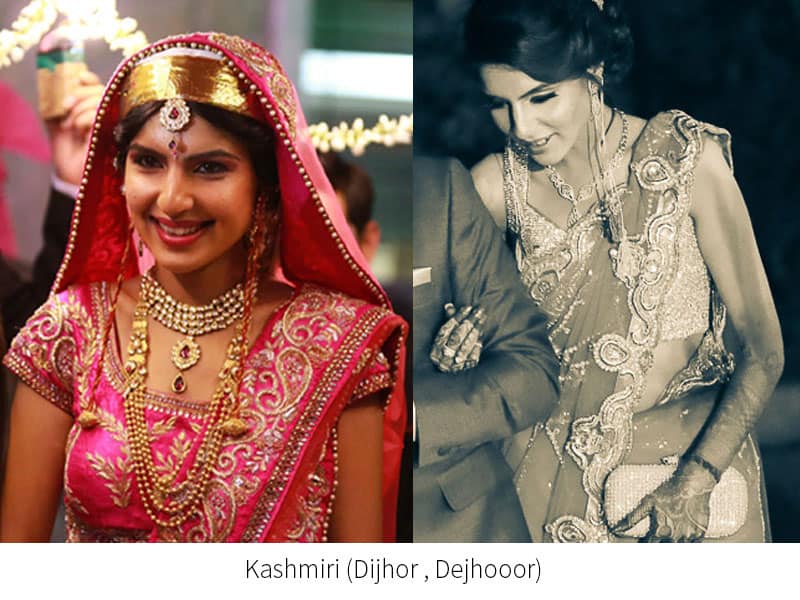
Image by Candidshutters
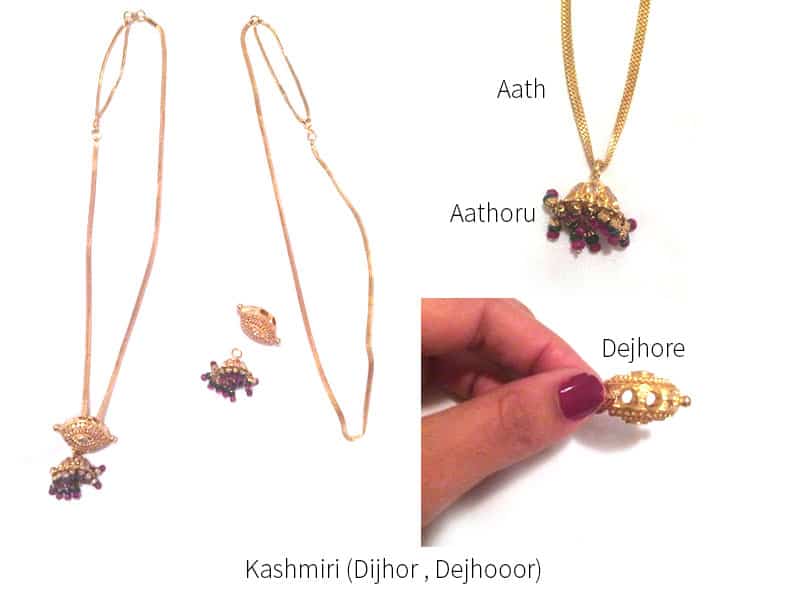
Image by Niyanta Watal
2. Sindhi Mangalsutra
In the Sindhi culture mangalsutra is a very important part of the wedding. It is a black and gold beaded chain with a pendant. The design of the mangalsutra depends on what the bride and the groom like. These days brides are opting out for a more modern design with the idea that they can wear it on a everyday basis.
3. Bihari Mangalsutra (Taagpaag)
In the Bihari culture, married women wear a mangalsutra known as Taagpaag. Women also wear toe rings known as “bichwa”, as a symbol of marriage. Toe rings are integral to Indian customs. They are considered essential for the woman’s reproductive system. Basically Taagpag is a another word for mangalsutra. It black beaded chain with pendant of their choice.
4. Tamil Mangalsutra (Thaali Kodi)
The Tamil mangalsutra or thaali is the token symbol of a Hindu marriage, just as wedding bands symbolize commitment, union and respect for one another. “Mangala Dharanam” is the ceremony when the groom puts on a Thaali on his bride. Thaali has a few more names such as Thirumangalayam, Mangalyam, Thaaly, Kodi.
Thaali comes in many shapes and forms. These derived mythologically or based on the family customs. The imprints on the Thaali have symbolic representations such as the family deity, Tulsi plant, Lord Shiva and Goddess Meenakshi. It weighs about 4-5 grams of gold. A family can choose to make it more elaborate by adding gold, coins, diamonds, gems to the main Thaali or on the sides as shown below.
During a Tamil wedding, Thaali is worn with a gold chain or “Manja Kayiru.” It is a yellow thread during ceremony. The yellow thread is replaced with a gold chain or a mangalsutra chain with black beads, known as “Nallapusalu”.
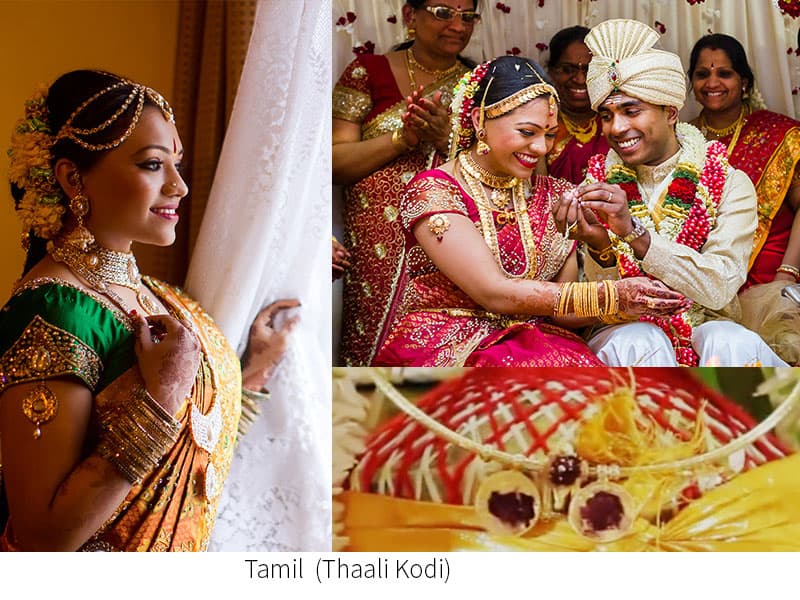
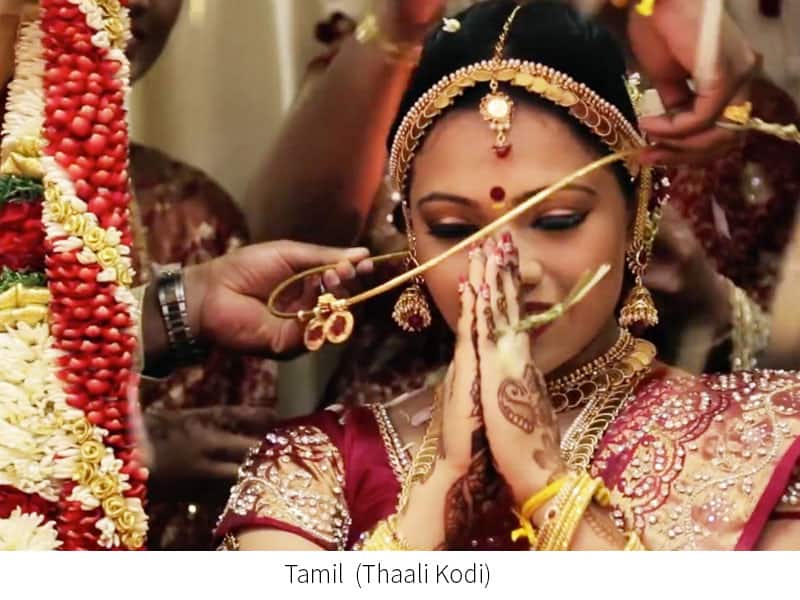
Images by Geru G Vaheesan
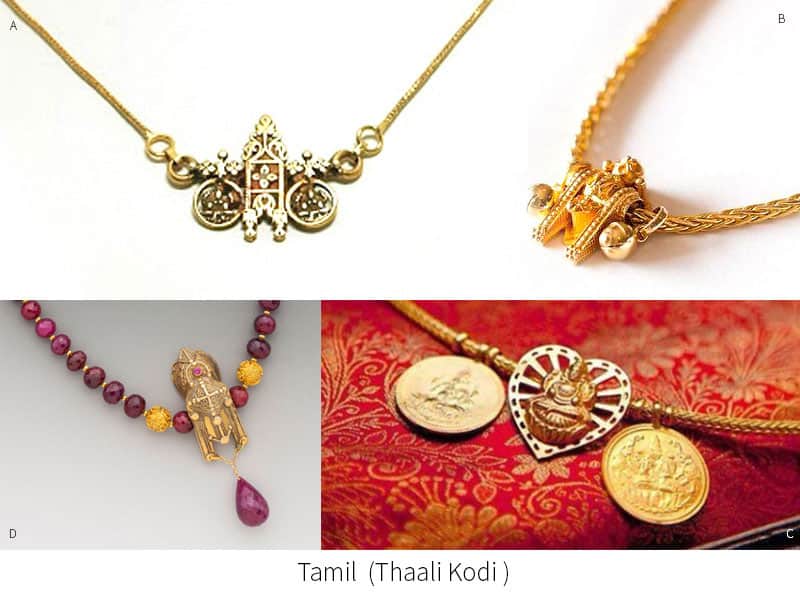
5. Kerela Mangalsutra (Minnu)
In Kerala, the Hindus call the mangalsutra “Thaali”’ and the Christians call it “Minnu”. Every Christian bride has a Minnu. The Minnu is a pendant with a cross, a symbol of Christianity, on a gold medallion shaped like a heart. The heart symbolises the concept of love. The cross represents the relationship a husband and wife must follow. The same relationship between Jesus and his bride, the church. Five or seven gold dots form the cross. The Minnu passed through seven strands of thread. Seven represents the bride, the groom, the couple’s parents and the church.
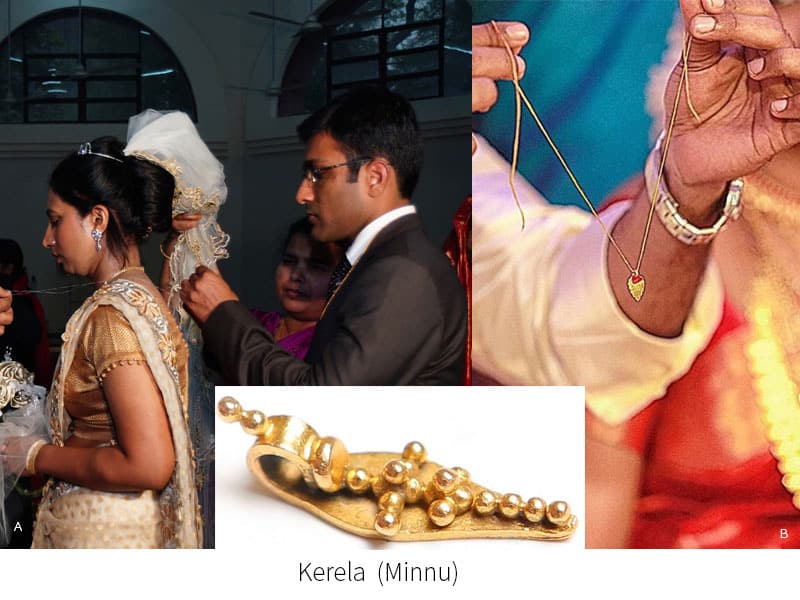
Images by A. Daliya Stanley, B
6. Telugu Mangalsutra (Mangalasutramu, Pustelu, Maangalyamu, Ramar Thaali, Bottu)
This Telugu mangalsutra has two round shape discs or coins. The groom’s side and the bride’s side each give a disc, tied on a yellow thread.
During the wedding ritual, the groom ties the two gold discs each with it’s own yellow thread, around the bride’s neck. The groom ties three knots of mangalsutra.
Sixteen days after the wedding the two discs are united. The groom or an elder in the family can perform this ritual. Black and coral beads threaded in a gold wire connect the two discs together. This is done to ensure they do not bump with each other. After the ceremony, the bride takes a bath and wears a new sari.
The unison of mangalsutra signifies the harmony between the two families. The mangalsutra represents the physical, mental and spiritual union of the couple.
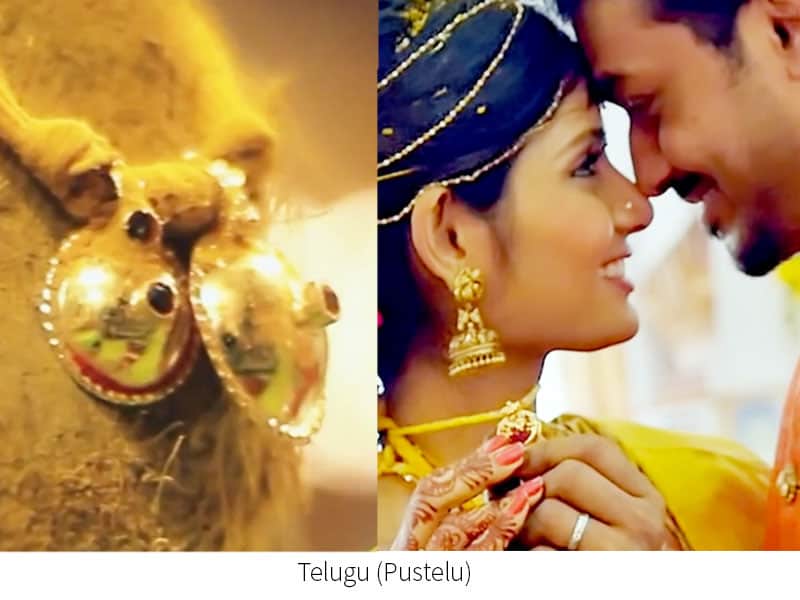
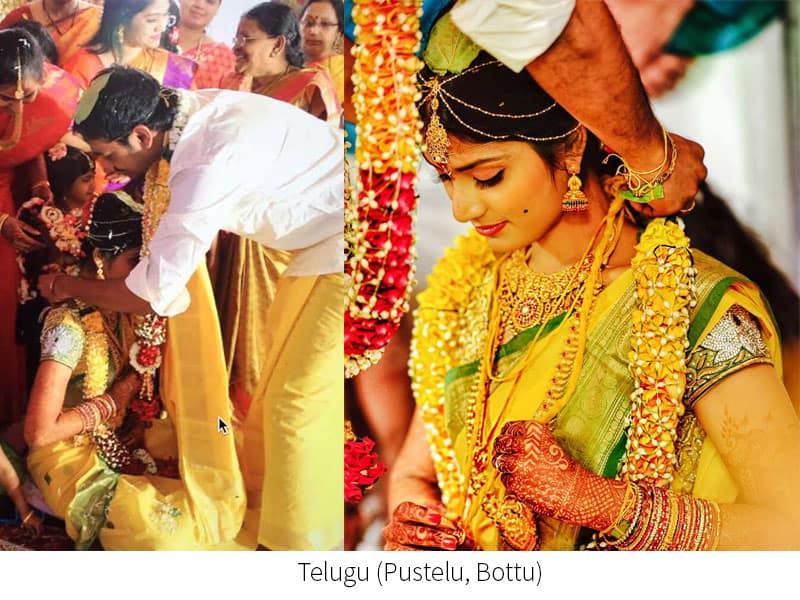
Images by Prashant ™ and Sushmita Seethala
Below are some common thali designs. People prefer different style and design based on their family tradition. “Bottu” is a round disc and half dome shape gold pendant.
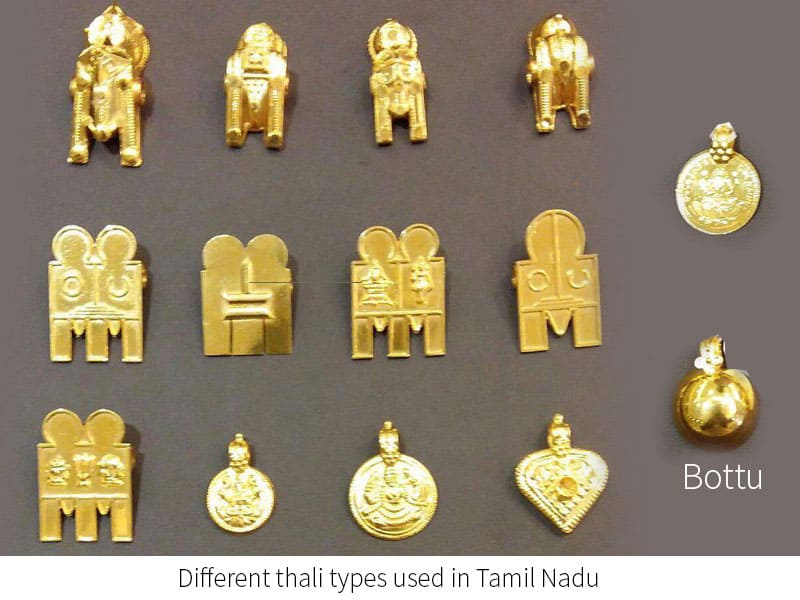
Image by Sabari Diamonds and Jewels, Tirupur, Tamil Nadu, India
Thali is not be seen. For this reason a sari is worn over to cover it. Primarily other females should not be able to see it and thus it acts as a evil eye protection. Thus brides prefer to have a decorative chain instead of a simple gold chain as shown below. There are many options available like the diamonds on the sides, gemstones, or different thickness or styles in gold chain. This way you can add a little bit of design as others will only see the chain.
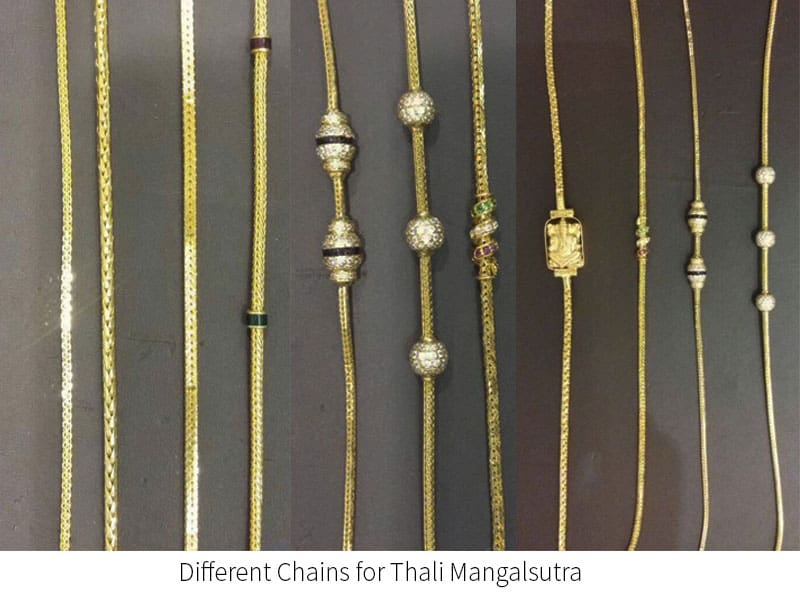
Image by Sabari Diamonds and Jewels, Tirupur, Tamil Nadu, India
Some people, particularly from the older generations still wear the yellow thread known as the “Manja-Kaira”.
7. Gujarati Mangalsutra
The Gujarati brides wear a nose stud to signify their married status. Gujarati’s wear a traditional mangalsutra with black beads with intricate gold pendant. These day we see most people opt for a diamond pendant with a short chain like the ones below.
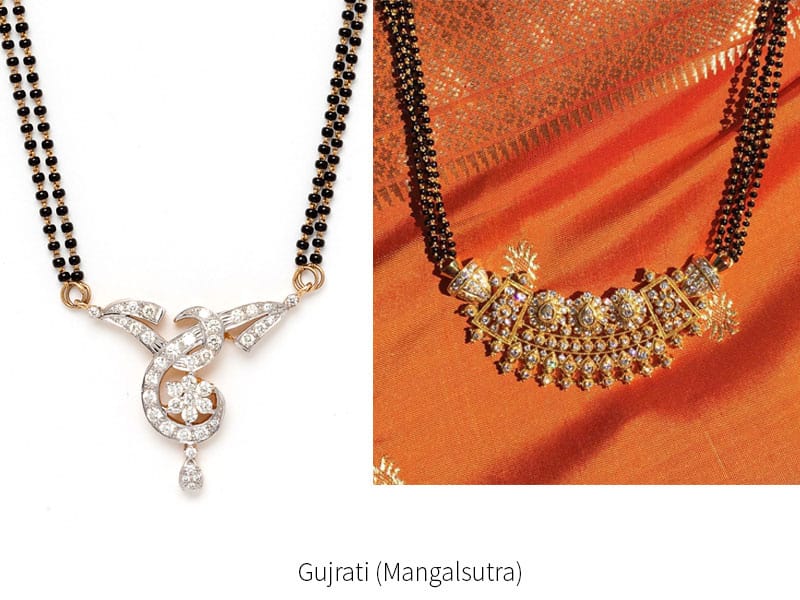
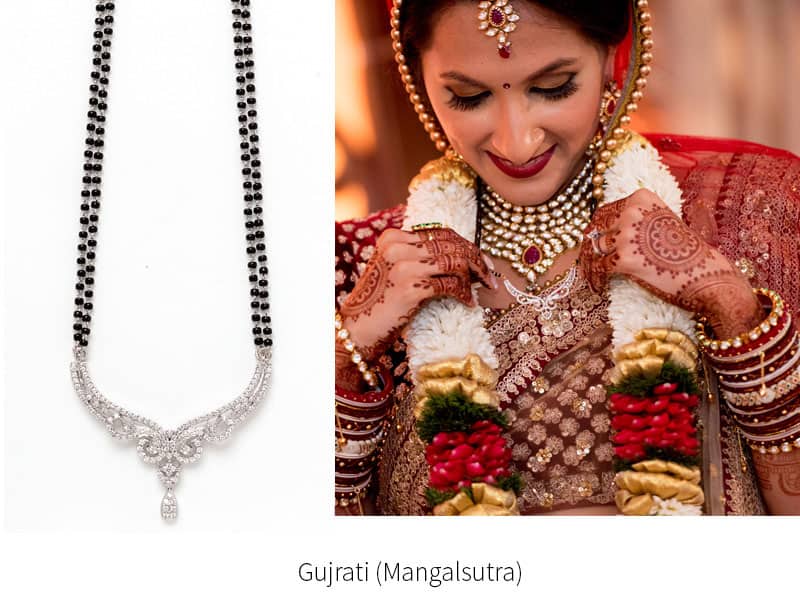
Image by Pooja Thaker
8. Maharashtrian Mangalsutra (Vati Mangalsutra)
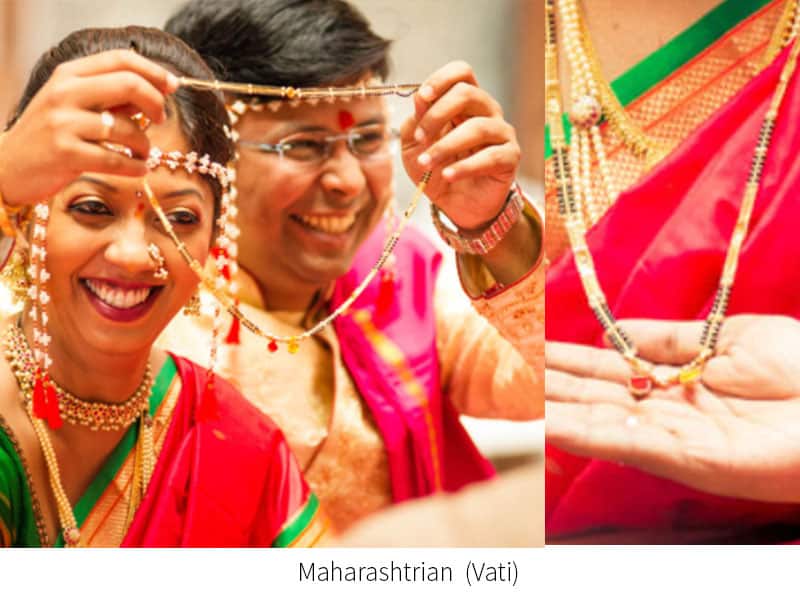
The Maharashtrian mangalsutra consists of black beaded chain with two bowl-shaped vatis. The gold vatis signify Shiva and Shakti.The two strands of beads fused together are symbolic of the husband and wife. Black beads are to keep the evil eye away and have a happy marriage. “Nirgun” and “Shagun” are two types of black beads. A Nirgun is when the whole chain is made of black beads. A Shagun when every nine back beads are separated by two gold beads.
Image by Whatknot
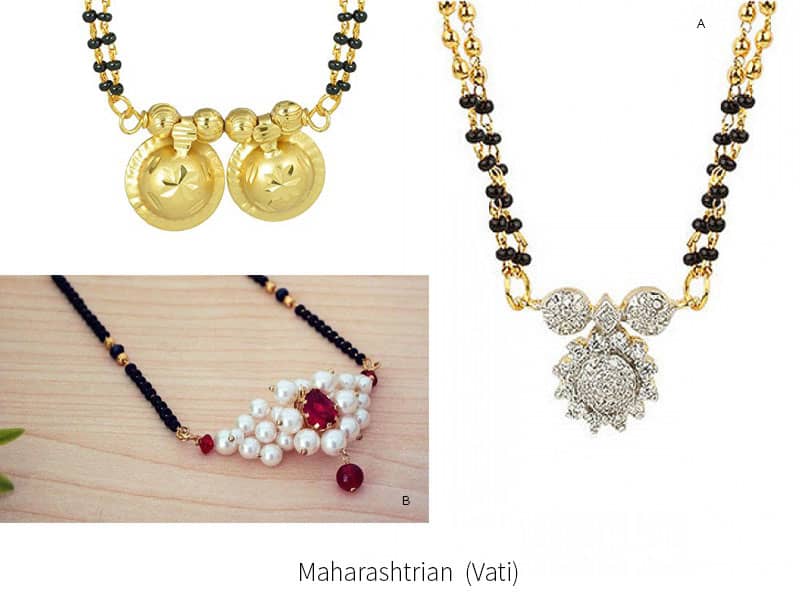
9. Karnatak Mangalsutra (Karthamani Pathak)
In the Coorg region of Karnataka, the Coorgi women wear “Karthamani Pathak” as the symbol of marriage, an equivalent of mangalsutra for them. Karthamani Pathak is the most important jewelry for any Kodava bride. Karthamani and Pathak are two separate pieces of jewelry.
The “Pathak” is the gold pendant which usually has a large gold coin with Lakshmi or Queen Victoria engraving and has small round rubies studded on the circumference of the coin. This coin pendant is surmounted by a cobra that stands for fertility. It may sometimes also have freshwater pearls hanging from it.
“Karthamani” is a necklace that is worn with the Pathak. Karthamani is made of corals and gold beads passed over a thread. The thread may be replaced with a gold chain.
A Kodava bride wears the Karthamani Pathak a day prior to her wedding. Unlike other cultures this Kodava version of mangalsutra is not tied by the groom. Instead the bride’s mother ties it a day before the marriage.
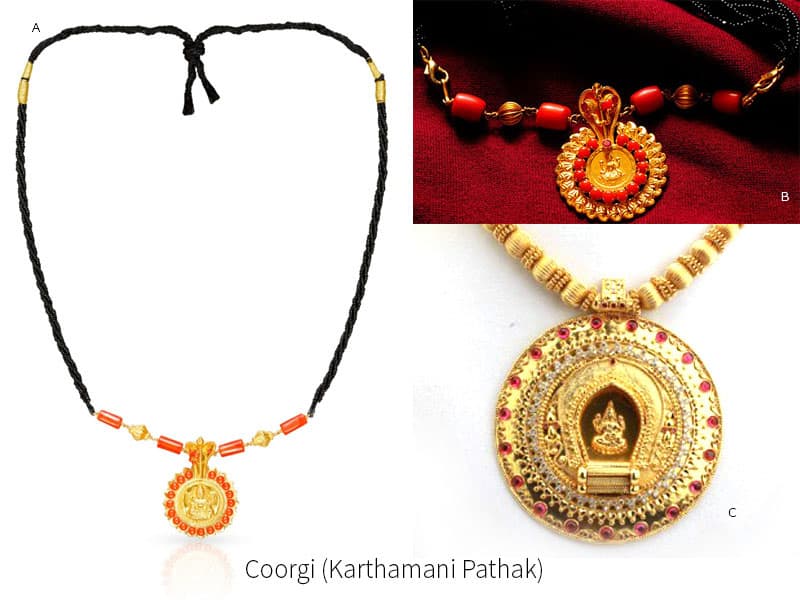
10. Mangalsutra for modern women in the 21st century
Many women no longer stay at home and take care of household chores on a full time basis. Women do have their professional careers and have to keep par with their surroundings at an international level. The mangalsutra has a lot significance and importance in a married woman’s life. However the design may not be appropriate with the modern outfits. Thus women no longer wear it on a everyday basis.
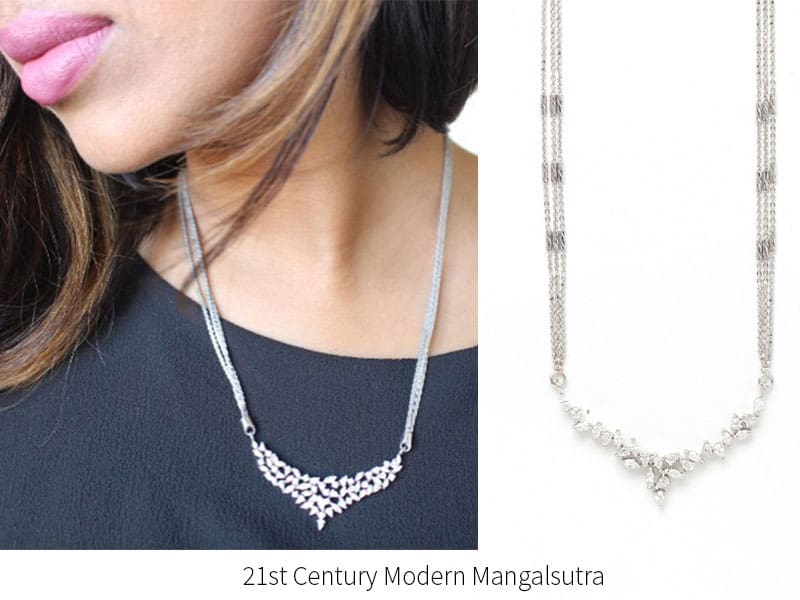
We help brides customize their mangalsutra based on their cultures. Our new mangalsutra designs are more modern and versatile. The design reflects the brides modern lifestyle while maintaining the cultural signifance. Below are some of our modern managalsutras. Hope you love them.
Image via @classtige
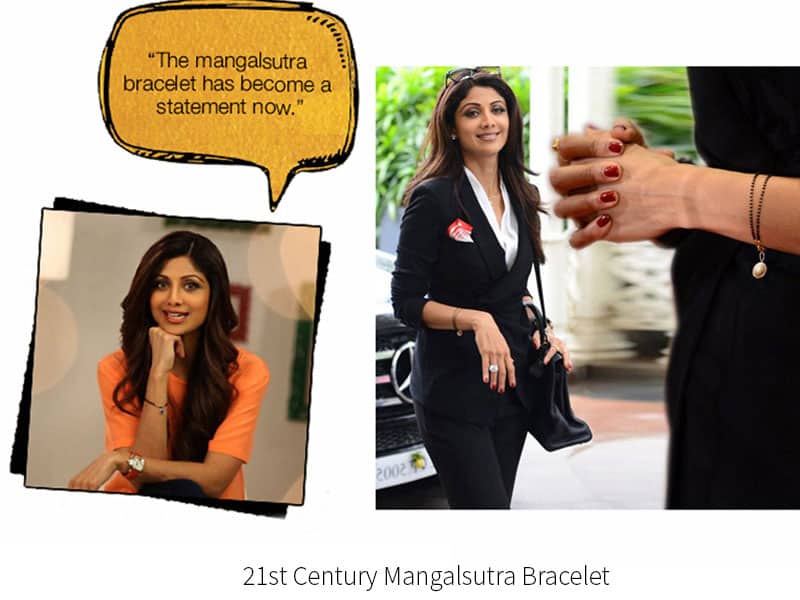
Image by Satyug, Mangalsutra Bracelet – Designed by Shilpa Shetty
Conclusion
In this post, we’ve covered:
- Meaning of the mangalsutra in different Indian cultures
- Review elements of mangalsutras from different states and cultures
- Differences between mangalsutras such as Thaali, Bottu, Karthamani Pathak, Vati, Taagpaag, Minnu, Dijhor, Dejhooor and more.
- Mangalsutra design options available to moderns brides of the 21st century
Hope you enjoyed reading this article and got a lot of value from it. If there is any culture that we’ve not covered, let us us in the comments below. We would love to hear what your experience has been with the mangalsutra.
Click to view our latest mangalsutra designs.
If you would like to design your custom mangalsutra, please contact us here.
Ps: Don’t forget to download this free mangalsutra buying checklist that I have created. It will help you choose the perfect managlsutra that you will actually wear and not store it in the bank.
The Ultimate Mangalsutra Buying Checklist
Sources:
www.Andra-Telugu.com
www.reginces.net
www.prernakalooraina.wordpress.com
www.kuberbox.com
Wiki Saint Thomas Christians
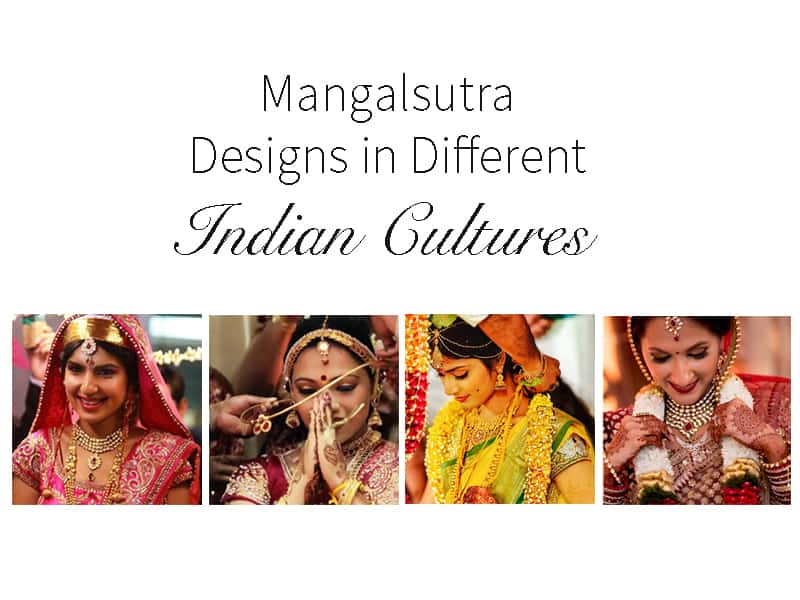
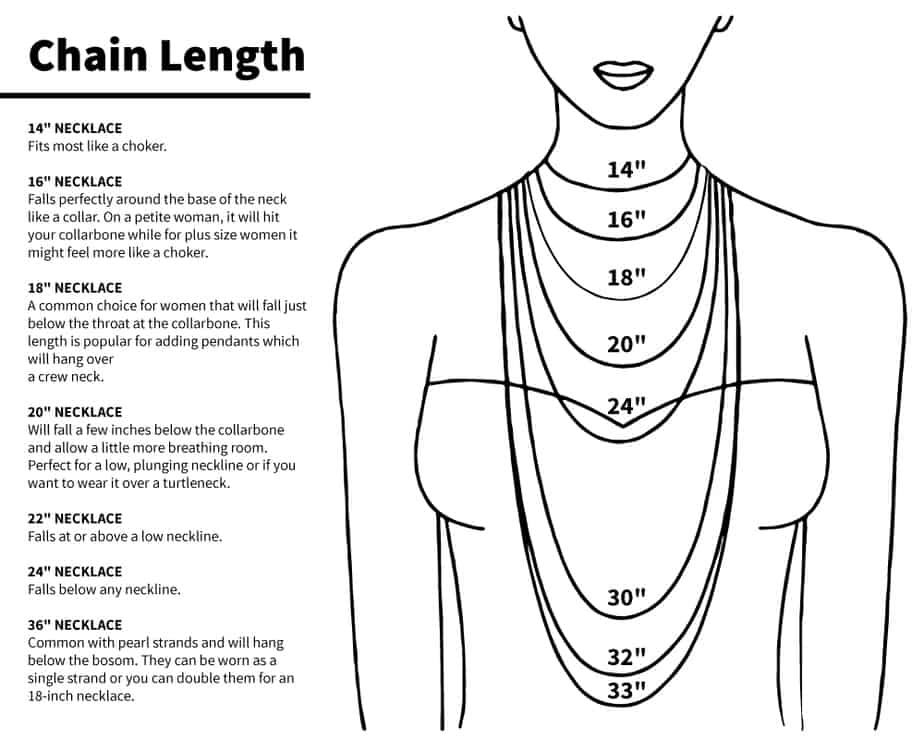
 Chat Now
Chat Now
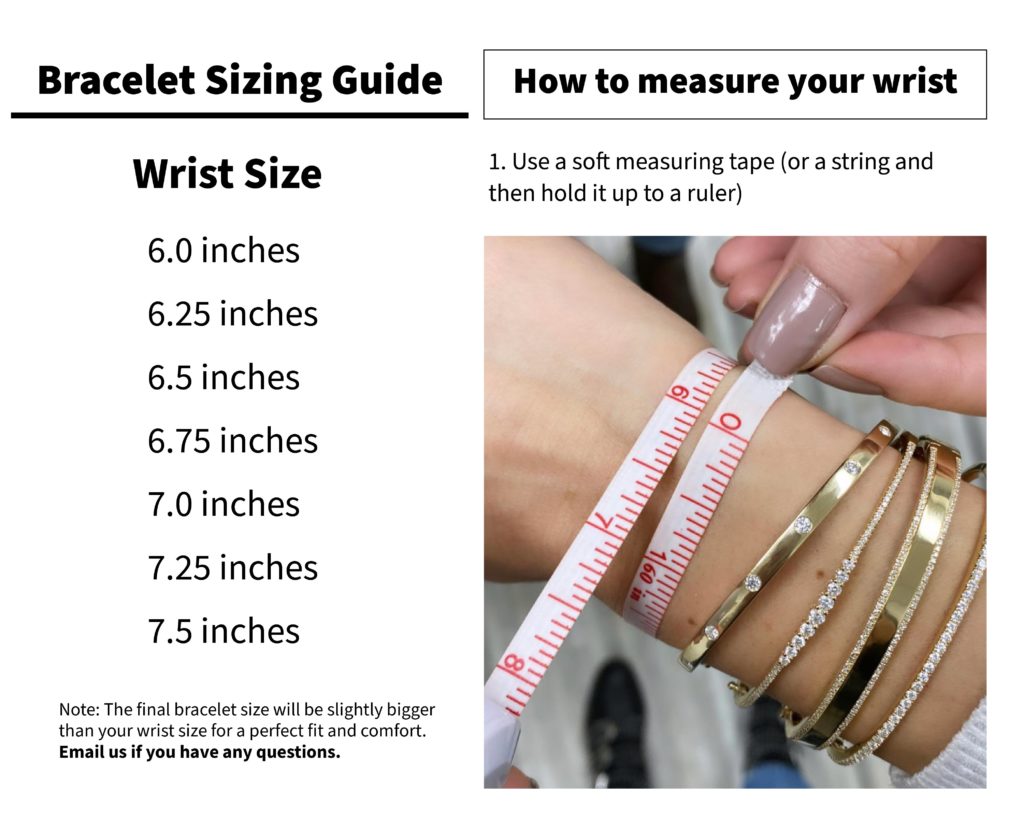
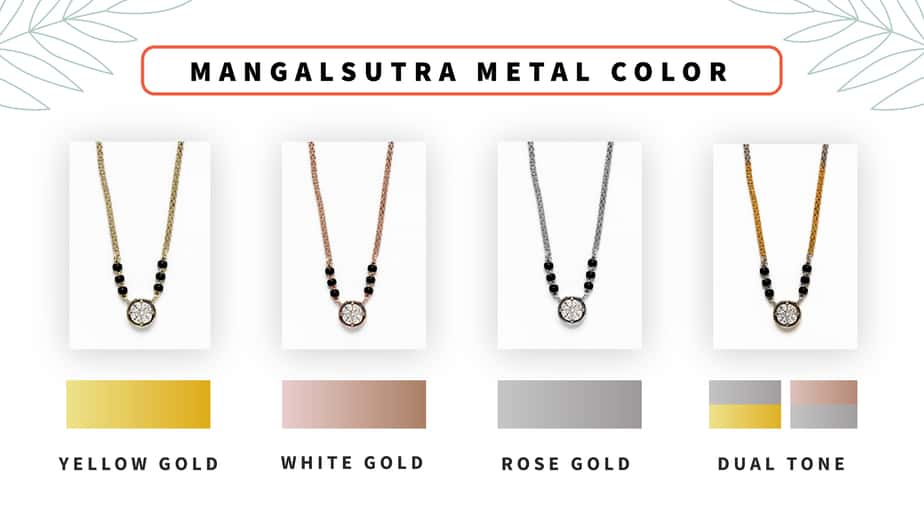
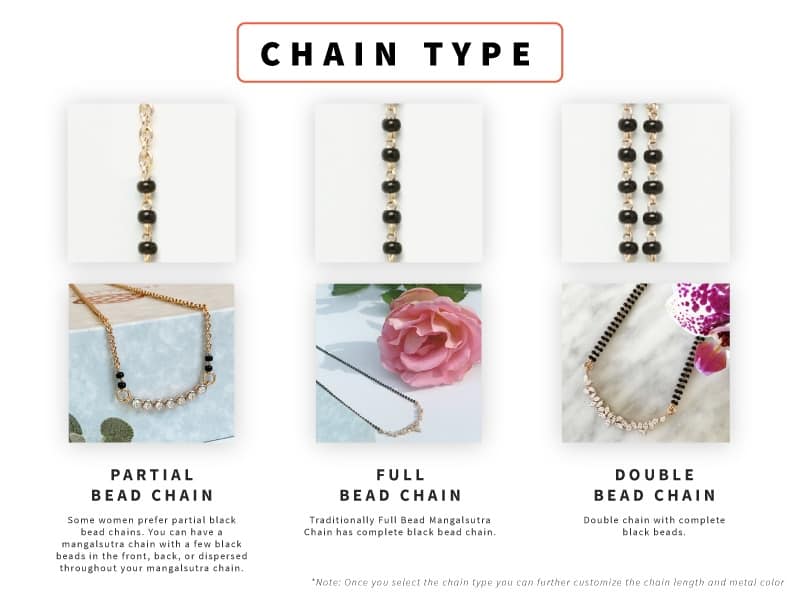
29 Thoughts on "Mangalsutra Designs in Different Indian Cultures"
How to Choose a Perfect Mangalsutra? – Sampat Jewellers Inc.
Rakhi
April 22, 2017Sir plz can u send me some designs of dejhoor
Jinal Sampat
July 17, 2017Hello Rakhi, Thank you for your message. Kindly email us contact@sampatjewellers.com and our design team will get back to you. Cheers
Yasmin
January 15, 2018Can you please send me muslim type mangalsutra…only in gold in this mangalsutra black moti are less
WEDDING NECKLACE BRIDAL WEAR
November 21, 2017Great post!! I’m glad to see you again. Thanks for the informative blog post. This post will really helpful to take decent pictures. Again thanks for sharing useful blog , i think really nice. thank you
indian diamond jewelry and mangalsutra
zircon vs cubic zirconia
November 23, 2017Great details about mangalsutra-designs-culture .thanks for sharing this really the contant is amazing informative,
interesting , motivative also which was i am looking for .
please keep updating step by step .
Geet
January 30, 2018Awesome post!! Really its very attractive post & all designs are here.
Dilasha
July 23, 2018Beautiful and knowledgeable post!
Loved your feed!
Thanks!
Krishnaya
March 4, 2019Wow! such a nice blog. I really like your blog as it explains all type of cultural mangalsutra. Thanks.
Gazal kothari
May 8, 2019“I liked the Marathi Mangalsutra most. Because the Maharashtrian Mangalsutra design is slightly simple to carry. The design carried a three-strand chain in which the centre strand is made from gold chain whiles the side’s one with black beads. I liked the Marathi Mangalsutra most. Because the Maharashtrian Mangalsutra design is slightly simple to carry. The design carried a three-strand chain in which the centre strand is made from gold chain whiles the side’s one with black beads.
I am also a designer, and I inspired from your blog.
Priyanshi pradhan
July 27, 2020This is nice and detailed information about mangalsutras. I really find its intresting and get to know about different religion.thanx for sharing such a nice information.
Ashok
November 30, 2020Excellent blog. Lots of useful information here, thanks for your effort!
Shine Gold and Diamonds
November 30, 2020Wow its really amazing to see different different type of Mangalsutra according to different different types cultures. Really each culture has its unique specialty in jewelry. Thanks for the informative blog post.
Rasheeda Parks
February 20, 2021Thank you for sharing I am very happy to see the different traditions
Of marriage and cultures being explained and up held
Jinal Sampat
February 20, 2021You are welcome 🙂
chirag patel
April 19, 2021Hey, your design and collection is just wow. Can’t take my eyes off. Thanks for sharing:)
SHINE GOLD & DIAMONDS
January 19, 2022Great post!! I’m glad to see you again. Thanks for the informative blog post. This post will really helpful to take decent pictures. Again thanks for sharing useful blog , i think really nice. thank you.
shinegd
February 3, 2022Wow! such a nice blog. I really like your blog
Dhanush Kamath
April 3, 2022This is a fantastic article about India’s diverse culture and traditions.
I’d also like to use this opportunity to add anoher community’s mangalsutra. I belong to GSB, which has two mangalsutra, one tied by the bride’s mother (dharemani) and the other by her husband (kasthali ).I think these kind of mangalsutra is only seen in the GSB so I thought i should add this to the list .
Thank you very much.
Jinal Sampat
April 11, 2022Hi Dhanush, thank you very much for the Sugesstion. We will try to include it in our article.
sunpreet singh
March 28, 2023very good website. thanks for sharing
Kanchanpushp
April 7, 2023This is the best blog on a variety of mangalsutra in India. I like it. Keep up the good work!
Irich Photography
December 14, 2023Thanks for sharing the traditions
Shree
March 8, 2024I love the lovely insights into mangalsutra designs and ways of life on your site! Informative and visually attractive content.
Swamy
May 17, 2024This article has provided some fantastic insights into Mangalsutra. The historical context added depth to the discussion and made me appreciate the artistry involved even more. This collection of artisanal Mangalsutra is stunning. It’s a testament to the skill and creativity of the craftsmen, and each piece tells a unique story.
Oman
June 12, 2024The mangalsutra, a significant symbol of marriage in various Indian cultures, differs widely in design and meaning across regions. For instance, Kashmiri brides wear Dejhoor, while Tamil brides don a Thaali. Despite these variations, all mangalsutras signify marital commitment and protection from negative energies. Modern designs often blend traditional elements with contemporary styles, catering to the evolving preferences of today’s brides.
Ajay Bhandari
June 18, 2024Sixteen days after the wedding the two discs are united
Rateqatar
July 2, 2024This article beautifully explores the rich cultural diversity of mangalsutra designs across various Indian communities. It highlights the significance of the mangalsutra, equivalent to a wedding ring in Western cultures, and its various forms such as the Thaali, Minnu, and Dejhoor among others. The detailed descriptions and images of traditional and modern designs showcase how this piece of jewelry adapts to contemporary lifestyles while maintaining its cultural essence. The section on modern mangalsutra designs is particularly insightful, reflecting the evolving roles of women. Overall, it’s a comprehensive and engaging read for anyone interested in Indian wedding traditions.
Irich photography
September 18, 2024very nice post